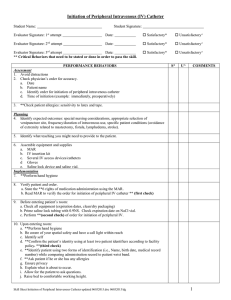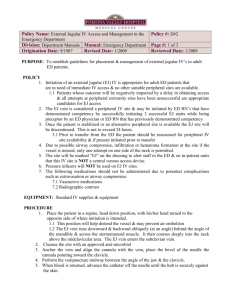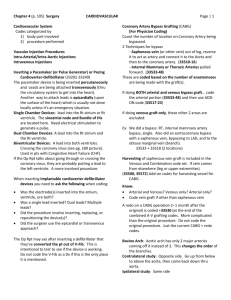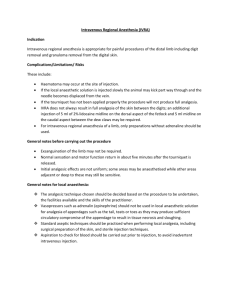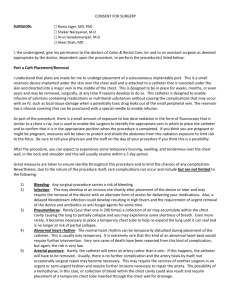IV access - School of Medicine, Queen`s University
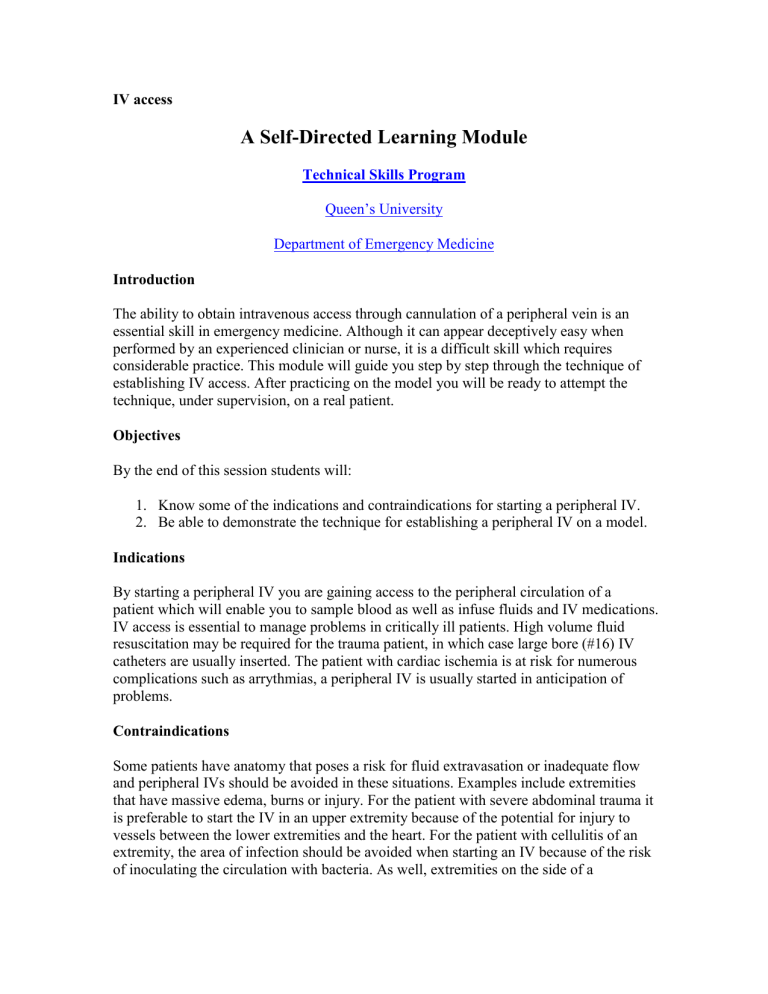
IV access
A Self-Directed Learning Module
Technical Skills Program
Queen’s University
Department of Emergency Medicine
Introduction
The ability to obtain intravenous access through cannulation of a peripheral vein is an essential skill in emergency medicine. Although it can appear deceptively easy when performed by an experienced clinician or nurse, it is a difficult skill which requires considerable practice. This module will guide you step by step through the technique of establishing IV access. After practicing on the model you will be ready to attempt the technique, under supervision, on a real patient.
Objectives
By the end of this session students will:
1.
Know some of the indications and contraindications for starting a peripheral IV.
2.
Be able to demonstrate the technique for establishing a peripheral IV on a model.
Indications
By starting a peripheral IV you are gaining access to the peripheral circulation of a patient which will enable you to sample blood as well as infuse fluids and IV medications.
IV access is essential to manage problems in critically ill patients. High volume fluid resuscitation may be required for the trauma patient, in which case large bore (#16) IV catheters are usually inserted. The patient with cardiac ischemia is at risk for numerous complications such as arrythmias, a peripheral IV is usually started in anticipation of problems.
Contraindications
Some patients have anatomy that poses a risk for fluid extravasation or inadequate flow and peripheral IVs should be avoided in these situations. Examples include extremities that have massive edema, burns or injury. For the patient with severe abdominal trauma it is preferable to start the IV in an upper extremity because of the potential for injury to vessels between the lower extremities and the heart. For the patient with cellulitis of an extremity, the area of infection should be avoided when starting an IV because of the risk of inoculating the circulation with bacteria. As well, extremities on the side of a
mastectomy or that have an indwelling fistula should be avoided because of concerns about adequate flow.
Complications
The main complications of an IV catheter are infection at the site and development of superficial thrombophlebitis in the vein that is catheterized.
Peripheral IV sites
Generally IV's are started at the most peripheral site that is available and appropriate for the situation. This allows cannulation of a more proximal site if your attempt fails. If you puncture a proximal vein first, and then try to start an IV distal to the site, the fluid may leak from the injured proximal vessel. The veins on the dorsum of the hand are used most commonly because they are easily accessible. If unable to start an IV on the dorsum of the hand the next preferred site is the veins of the forearm and then the median cubital vein that crosses the antecubital fossa. In trauma patients it is common to go directly to the median cubital vein as the first choice because it will accommodate a large bore IV and it is generally easy to catheterize. In circumstances where the veins of the upper extremities are inaccessible the veins of the dorsum of the foot or the saphenous vein of the lower leg can be used. In circumstances where no peripheral IV access is possible a central IV can be started. Central IV's are beyond the scope of this module and so will not be discussed further.
Universal precautions
The potential for contact with a patient's blood while starting an IV is high and increases with the inexperience of the operator. Gloves must be worn while starting an IV and if the risk of blood splatter is high, such as an agitated patient, the operator should consider face and eye protection as well as a gown. Trauma protocol calls for all team members to wear gloves, face and eye protection and gowns. As well, once removed from the protective sheath, IV catheters should either go into the patient or into an appropriate sharps container. Recapping needles, putting catheters back into their sheath or dropping sharps to the floor (an unfortunately common practice in trauma) should be strictly avoided.
Equipment
All necessary equipment should be prepared, assembled and available at the bedside prior to starting the IV. Basic equipment includes:
Appropirate size catheter 20G-30mm IV catheter
non-latex tourniquet alcohol swab
non-sterile 2x2 gauze
sterile 2x2 gauze (this is not practice in nursing)
6x7cm Tegaderm™ Transparent Dressing
3 pieces of 2.5 cm tape approximately 10 cm in length
IV bag with solution set (tubing) (flushed and ready)
sharps container
To prepare the IV line, protective caps are removed from the fluid bag and the spiked end of the IV tubing. The regulating clamp for the IV line should be closed. The spiked end of the IV tubing is inserted into the receptacle on the IV bag while holding the IV bag inverted. The bag is then held upright with the IV line hanging from the bottom. The drip chamber should be filled half-way by pinching it and releasing. Following this, the bag should be hung from the IV pole, at a point above the patient, and the regulating clamp should be opened to "flush" the line of air bubbles.
Step 1: Apply tourniquet and prepare skin
1.
Apply tourniquet to the IV arm above the site.
2.
Visualize and palpate the vein
3.
Cleanse the site with an alcohol swab using an expanding circular motion.
Step 2: Insert catheter
1.
Prepare and inspect the catheter.
2.
Stabilize the vein and apply countertension to the skin.
3.
Insert the stylet through the skin and observe for "flash back" as blood slowly fills the flash back chamber.
4.
Reduce the angle of the needle and advance approximately 1 cm further into the vein. Students are often unsuccessful at establishing IV access because this step is omitted. Remember, by reducing the angle and advancing further into the vein, you are ensuring that the catheter (and not just the needle) is in fact inside the lumen of the vein.
(See illustration below for more details: In Sequence A , the catheter pushes on the outside of the vessel wall and remains outside of the vein - this is the incorrect method. In Sequence B , the catheter enters and remains in the lumen of the vein - this is the correct method.)
5.
Slowly advance the catheter over the needle and into the vein while keeping tension on the vein and skin.
6.
Press the white button and observe the spring-loaded needle disappear into the stylet.
7.
Place the stylet into the sharps container.
8.
Remove the tourniquet.
Step 3: Connect IV
Connect the IV tubing.
Credits
Congratulations!
You have now completed the IV access module.
Credits
This web-based module was developed by Adam Szulewski based on content written by Dr. Bob McGraw for the Queen's University Department of
Emergency Medicine Summer Seminar Series and Technical Skills Program.
The module was created using exe : eLearning XHTML editor with support from
Amy Allcock and the Queen's University School of Medicine MedTech Unit .
License
This module is licensed under the Creative Commons Attribution Non-Commercial No
Derivatives license. The module may be redistributed and used provided that credit is given to the author and it is used for non-commercial purposes only. The contents of this presentation cannot be changed or used individually. For more information on the
Creative Commons license model and the specific terms of this license, please visit creativecommons.ca.
